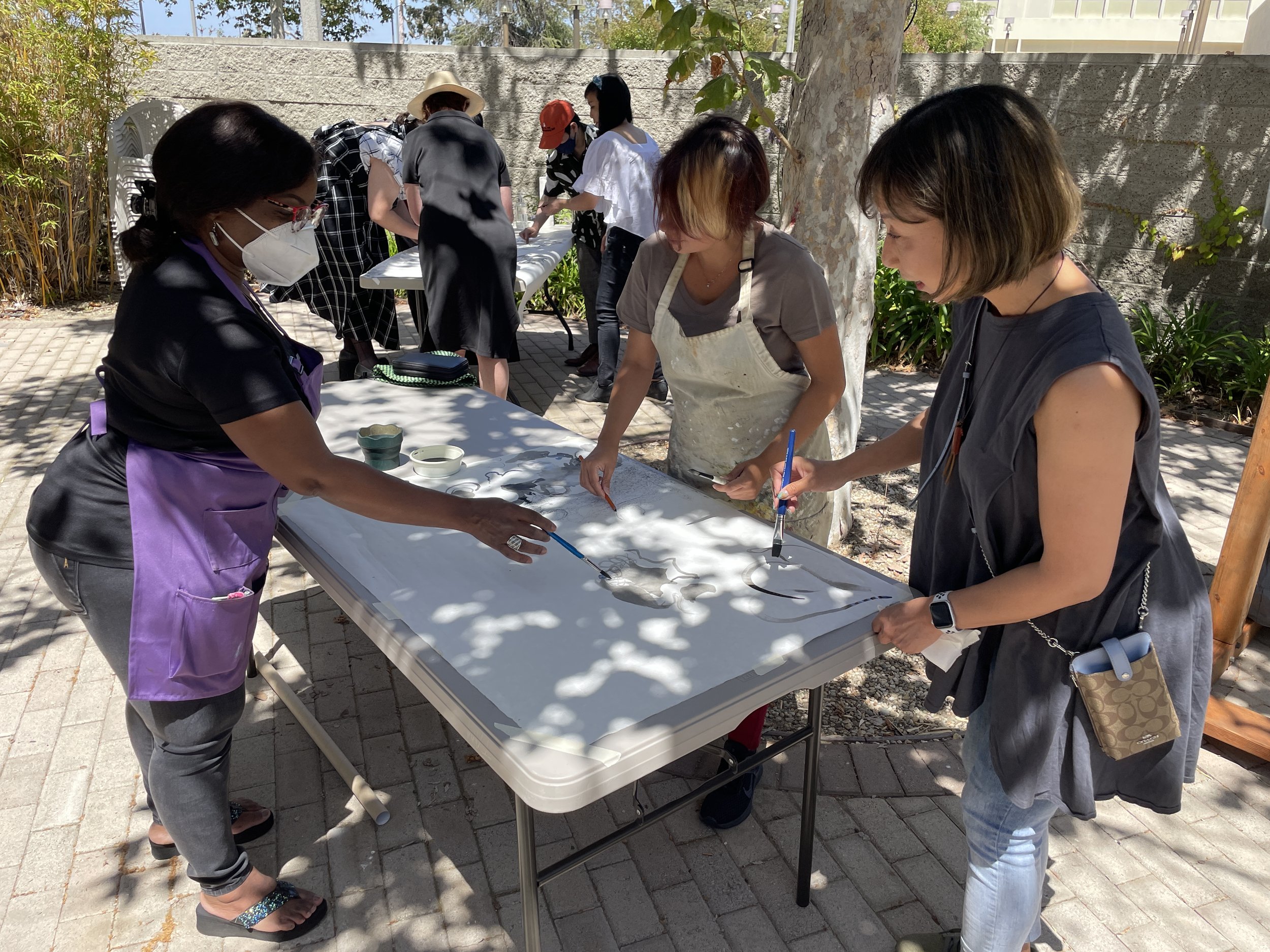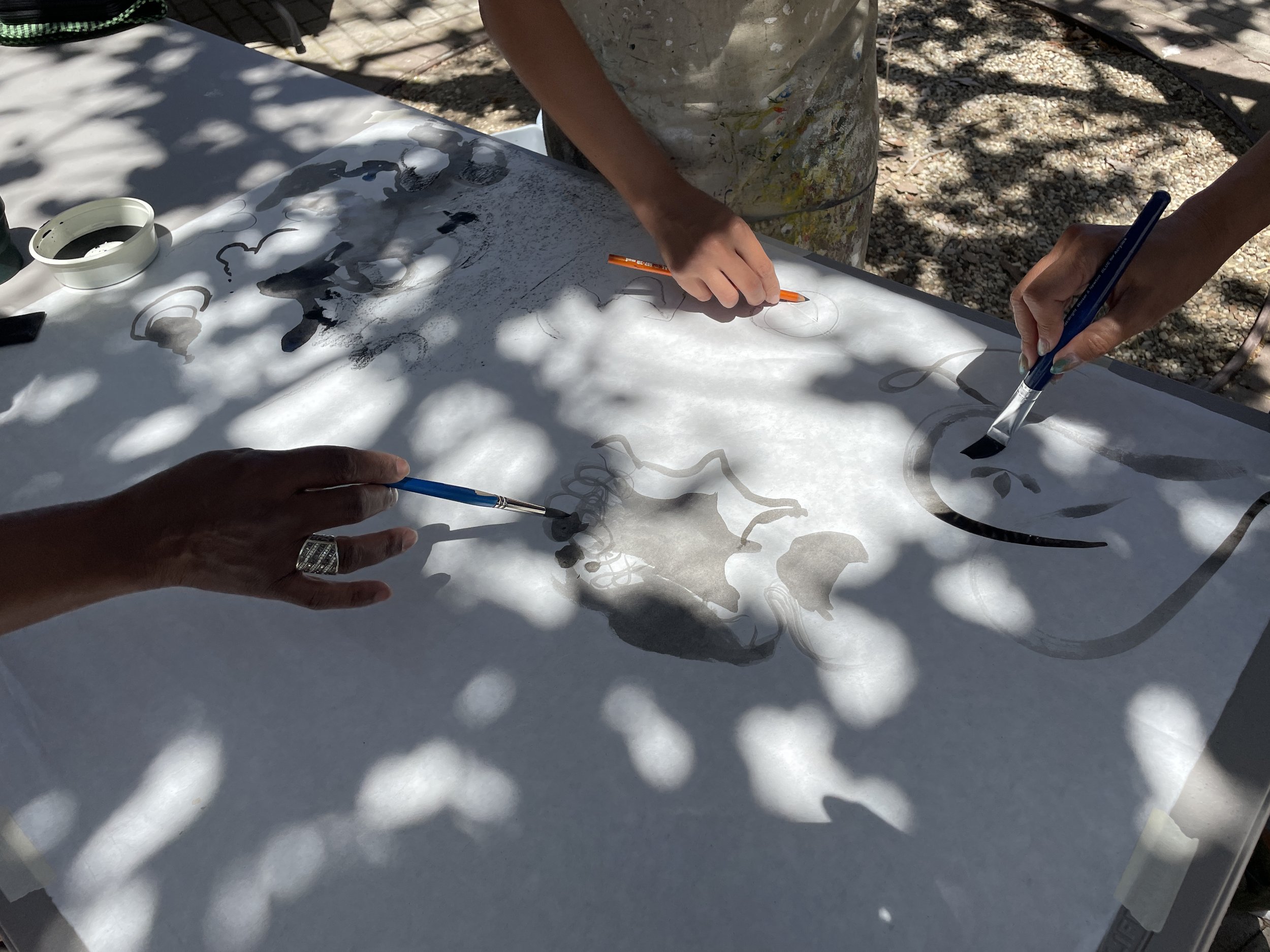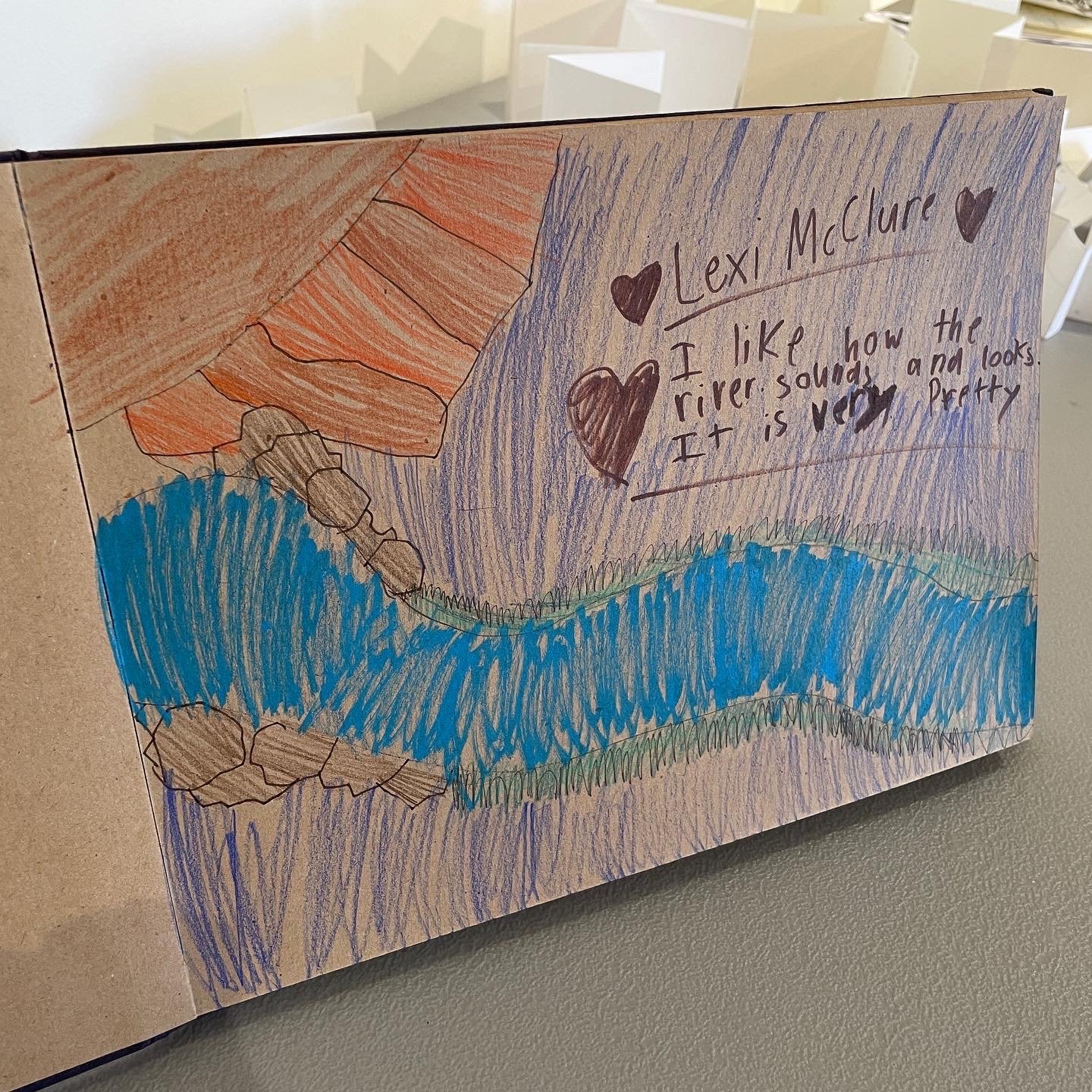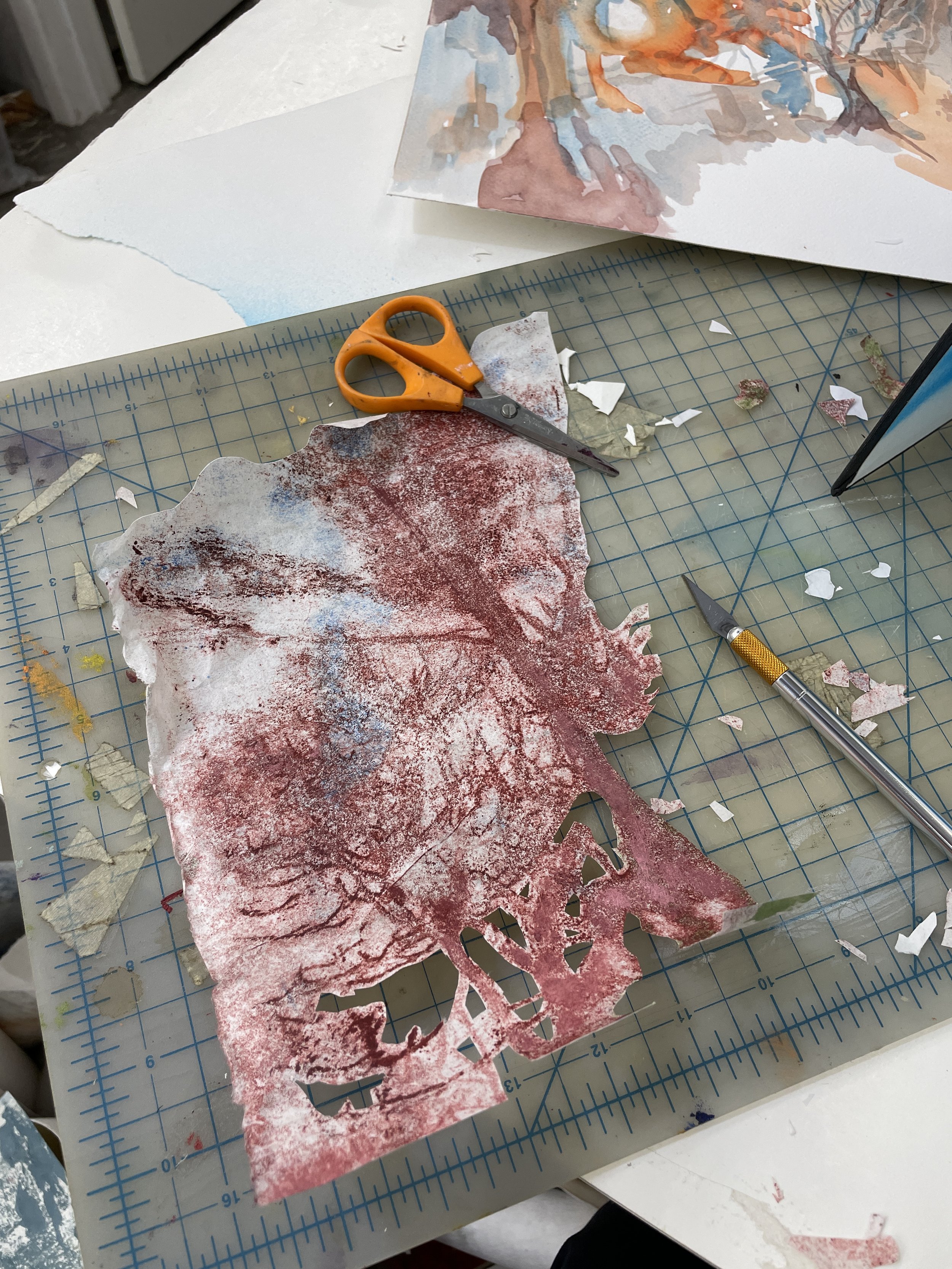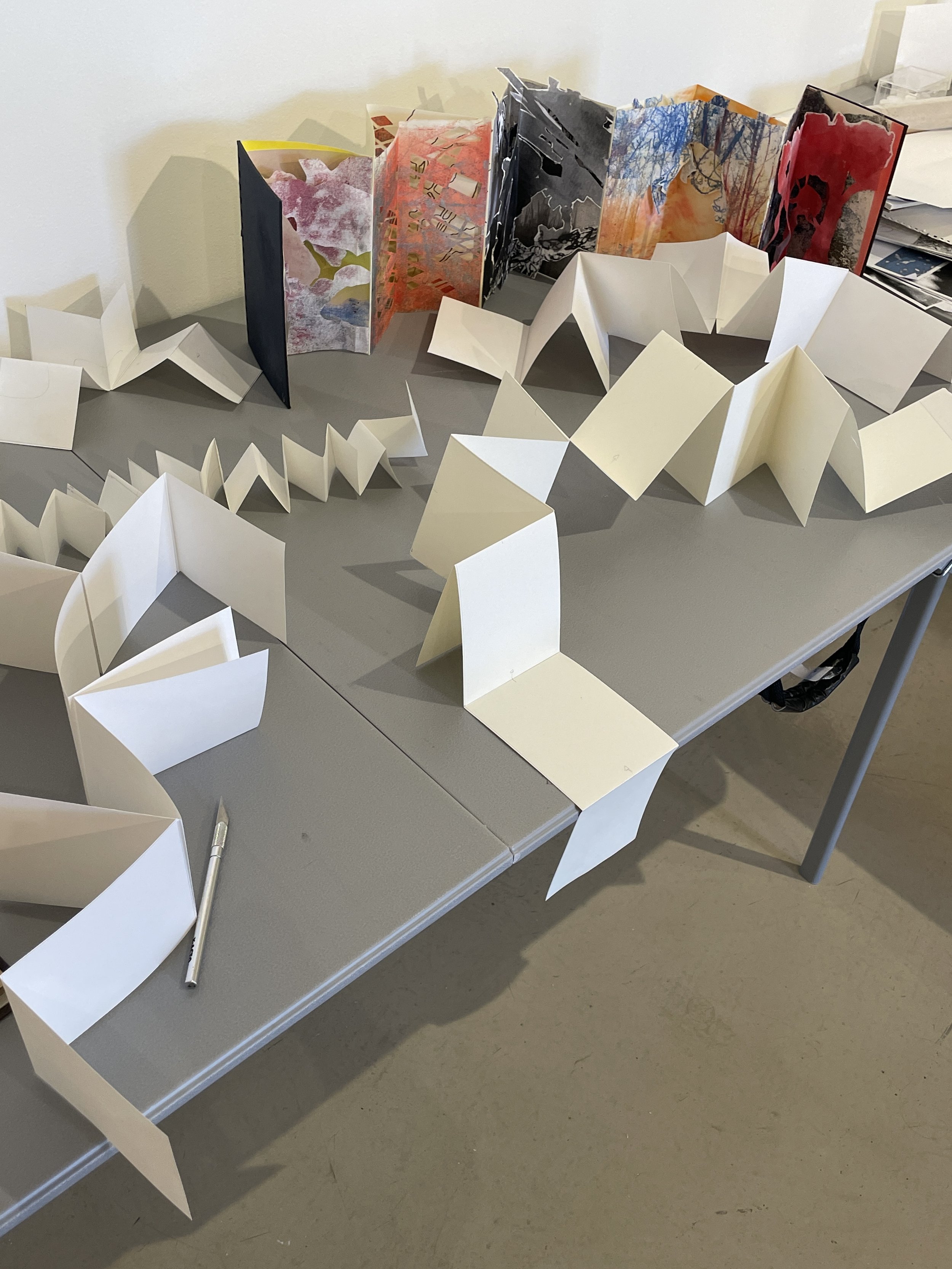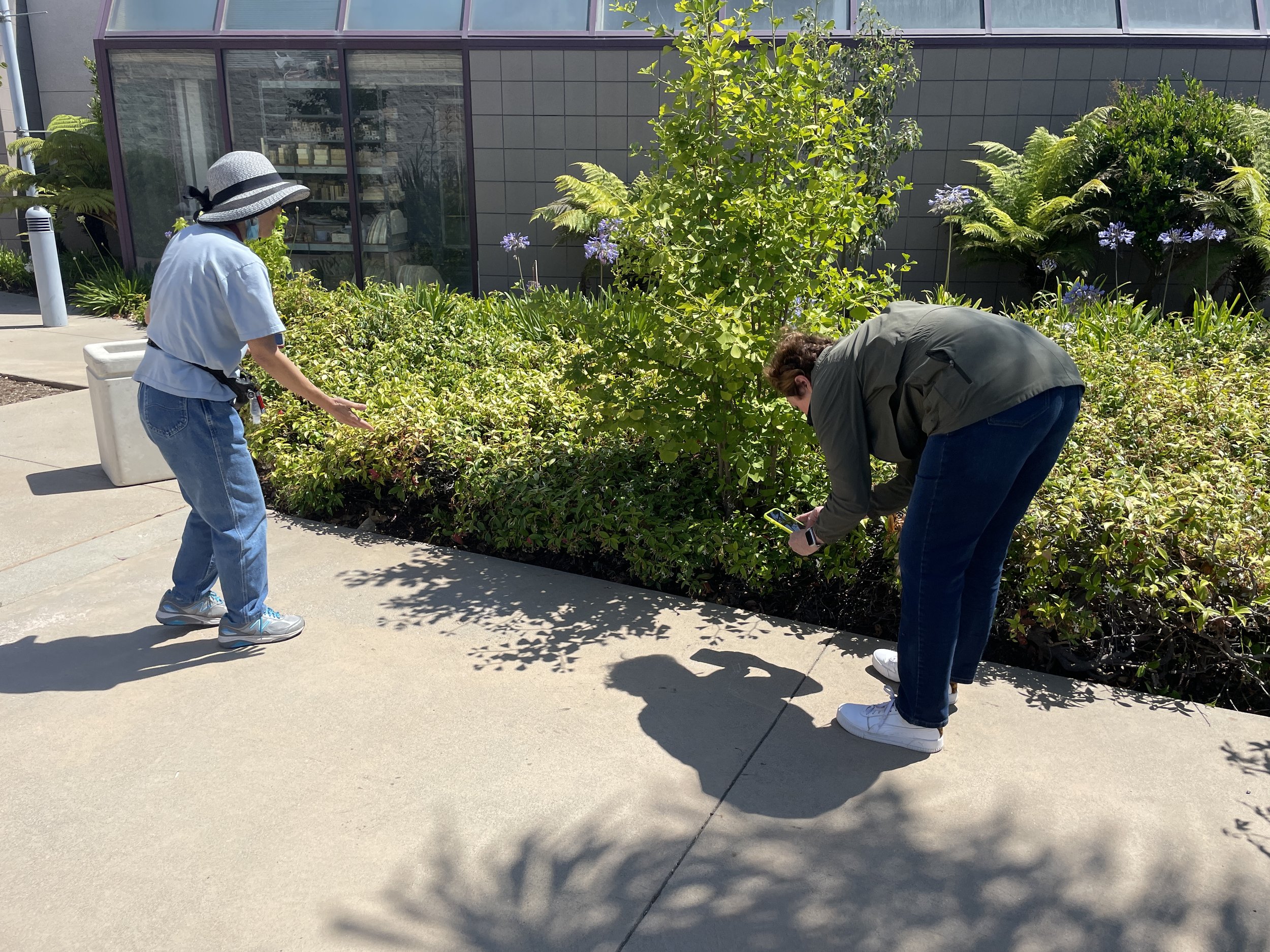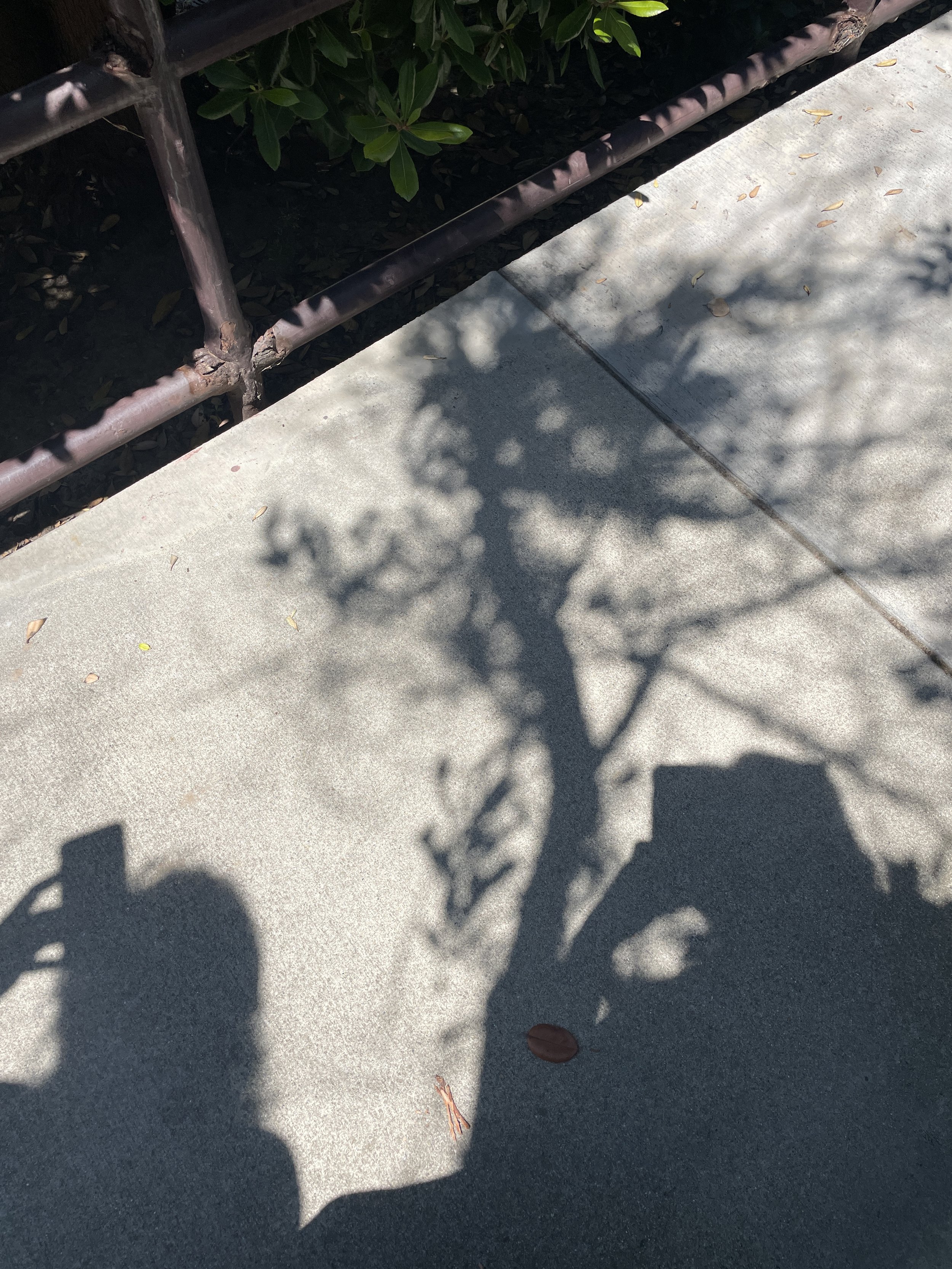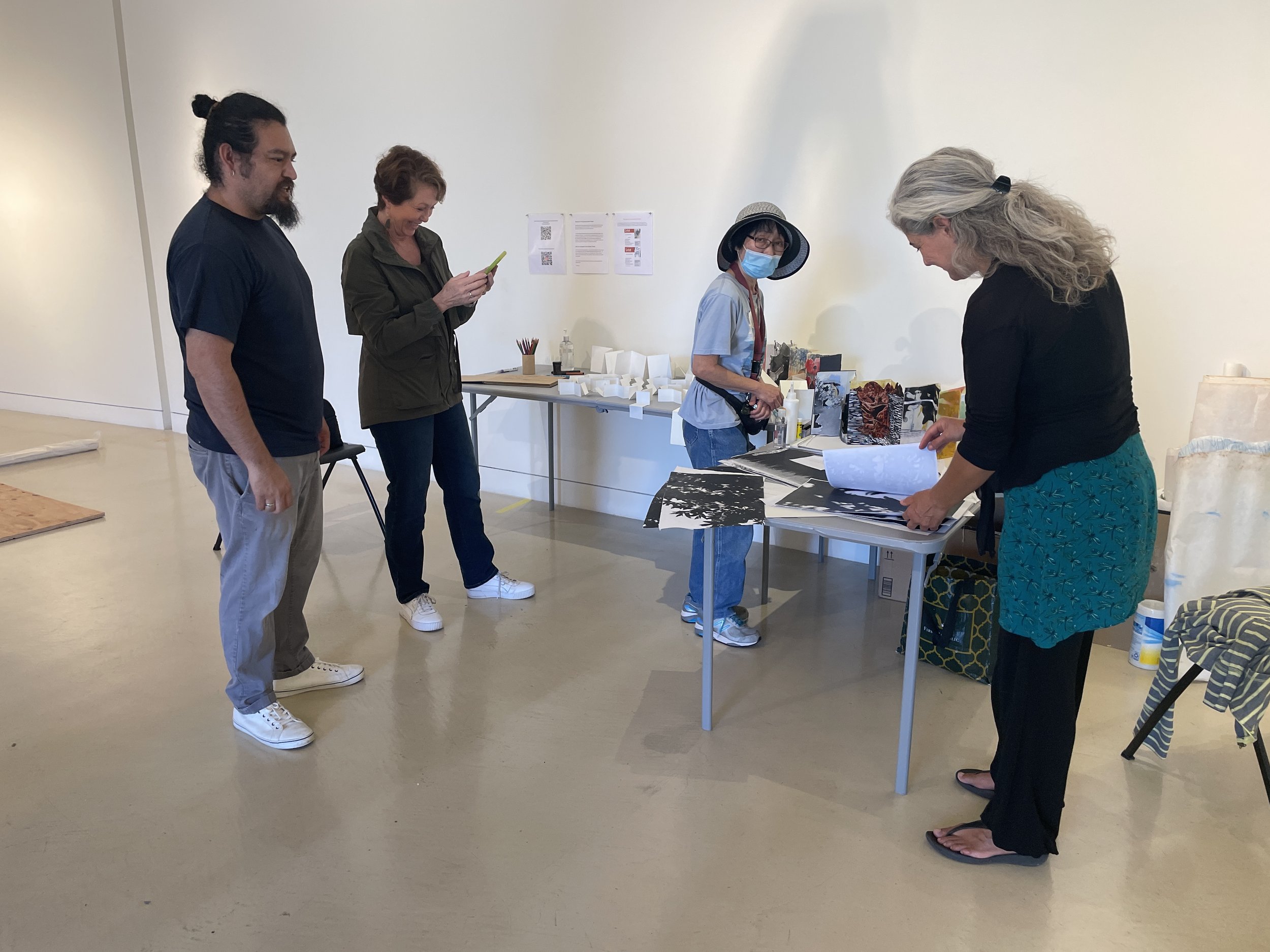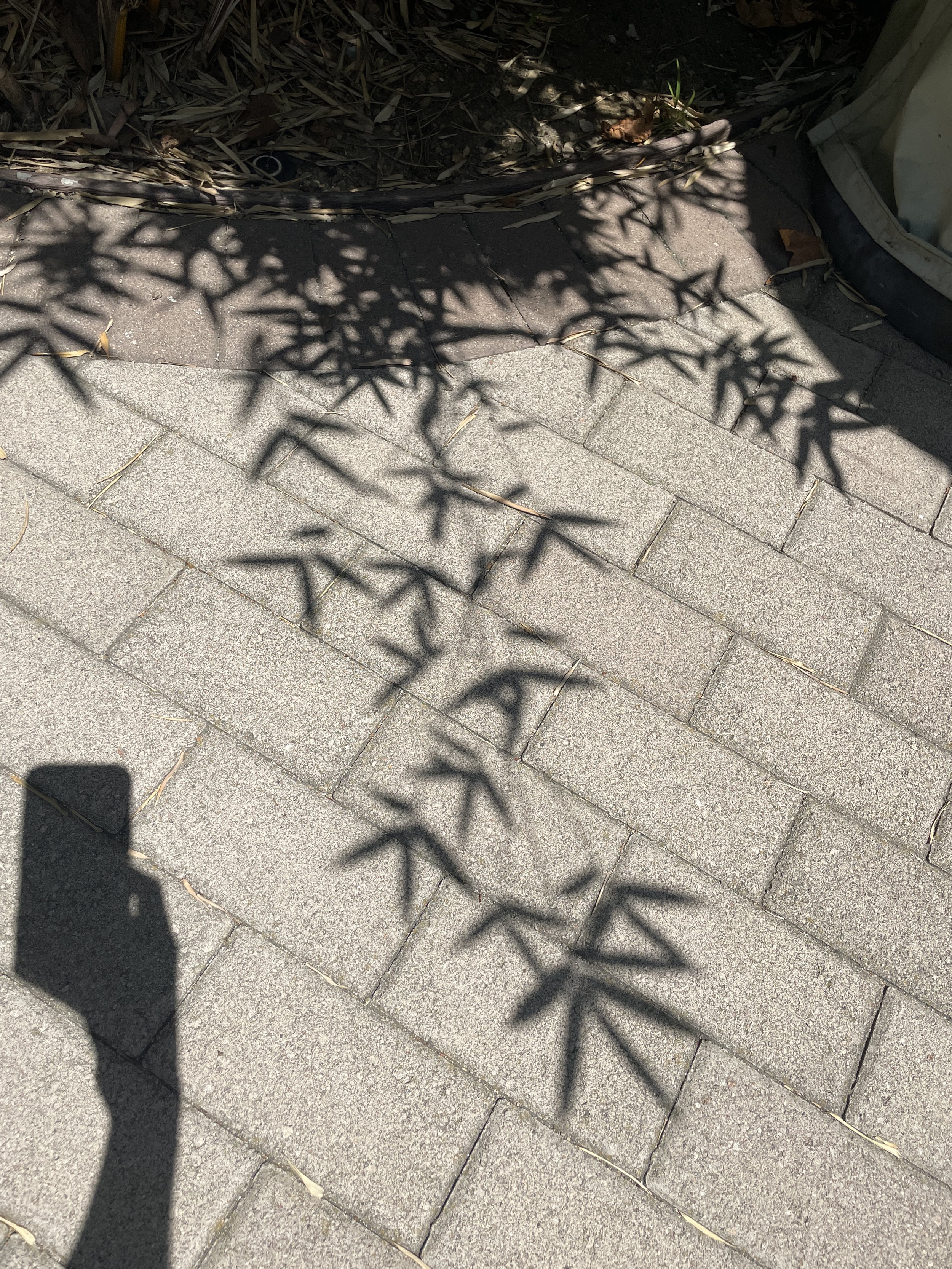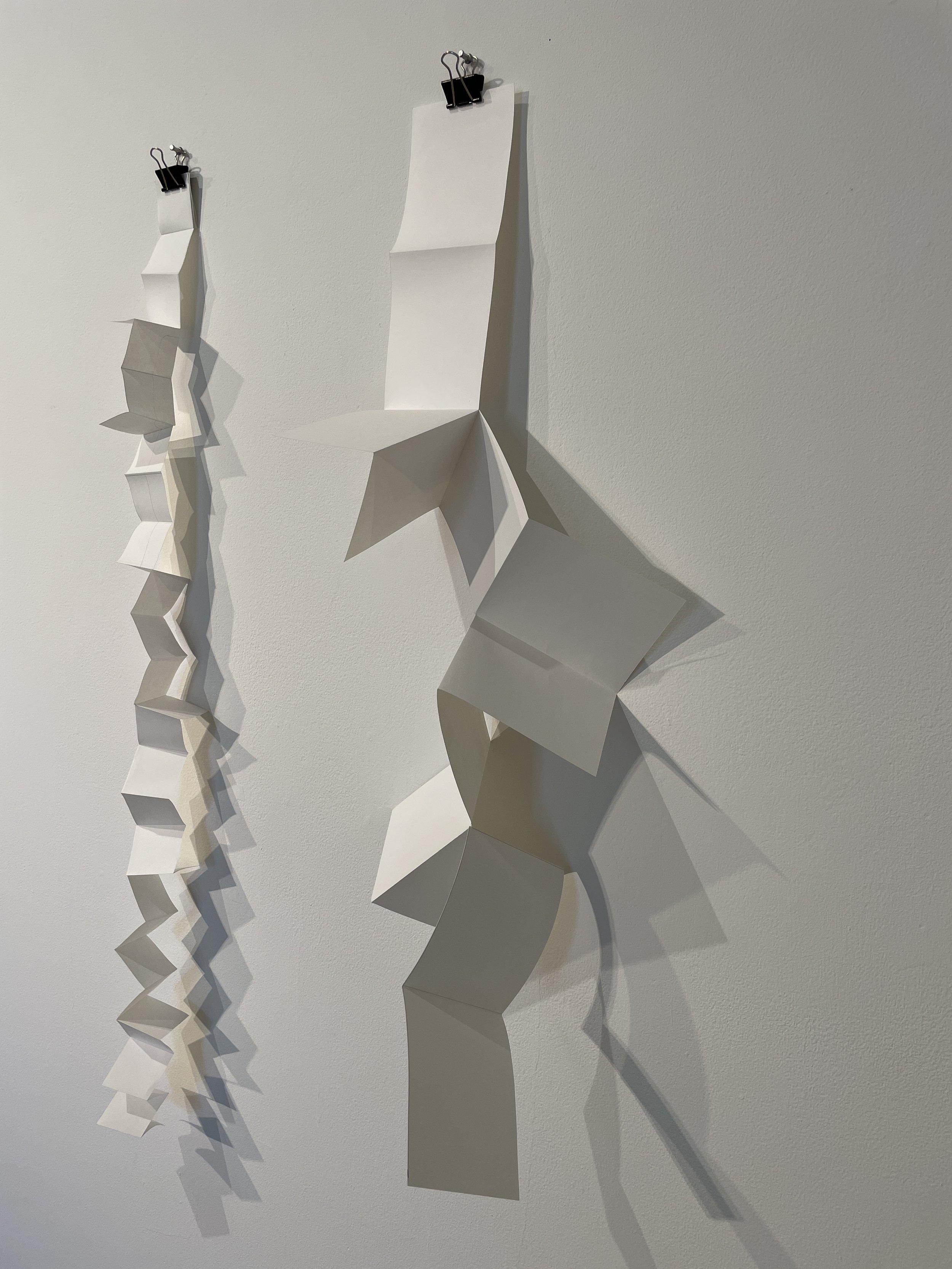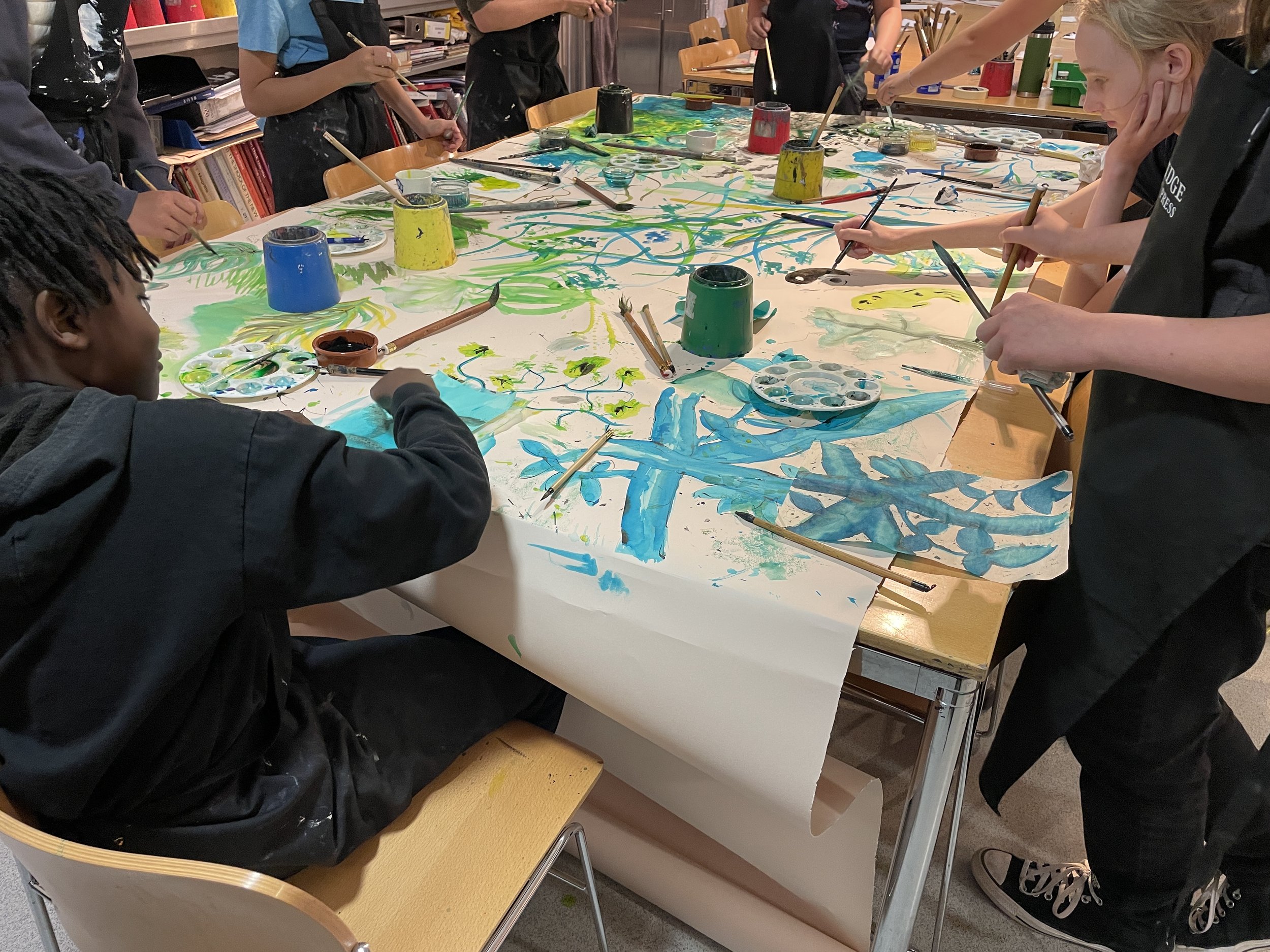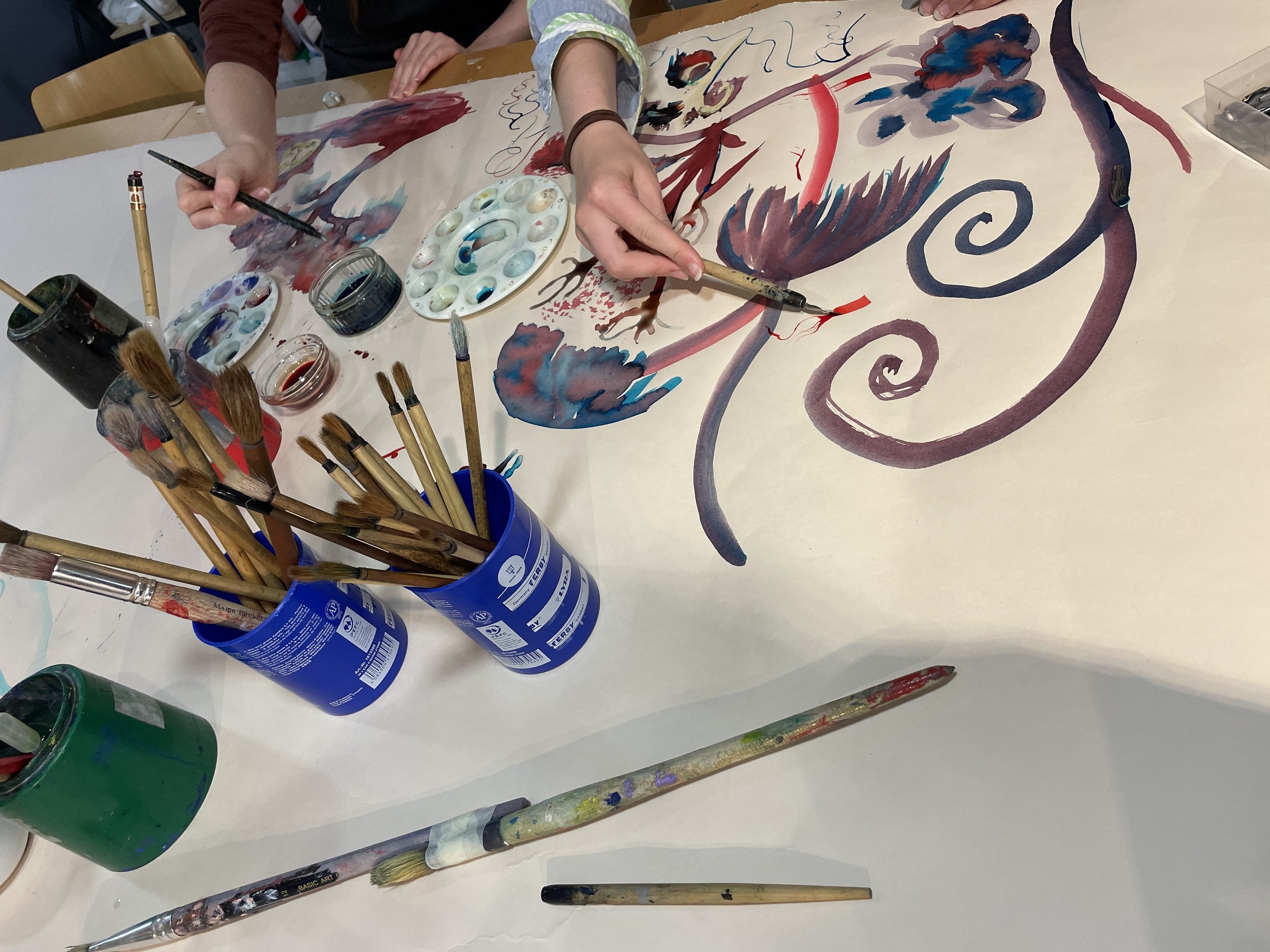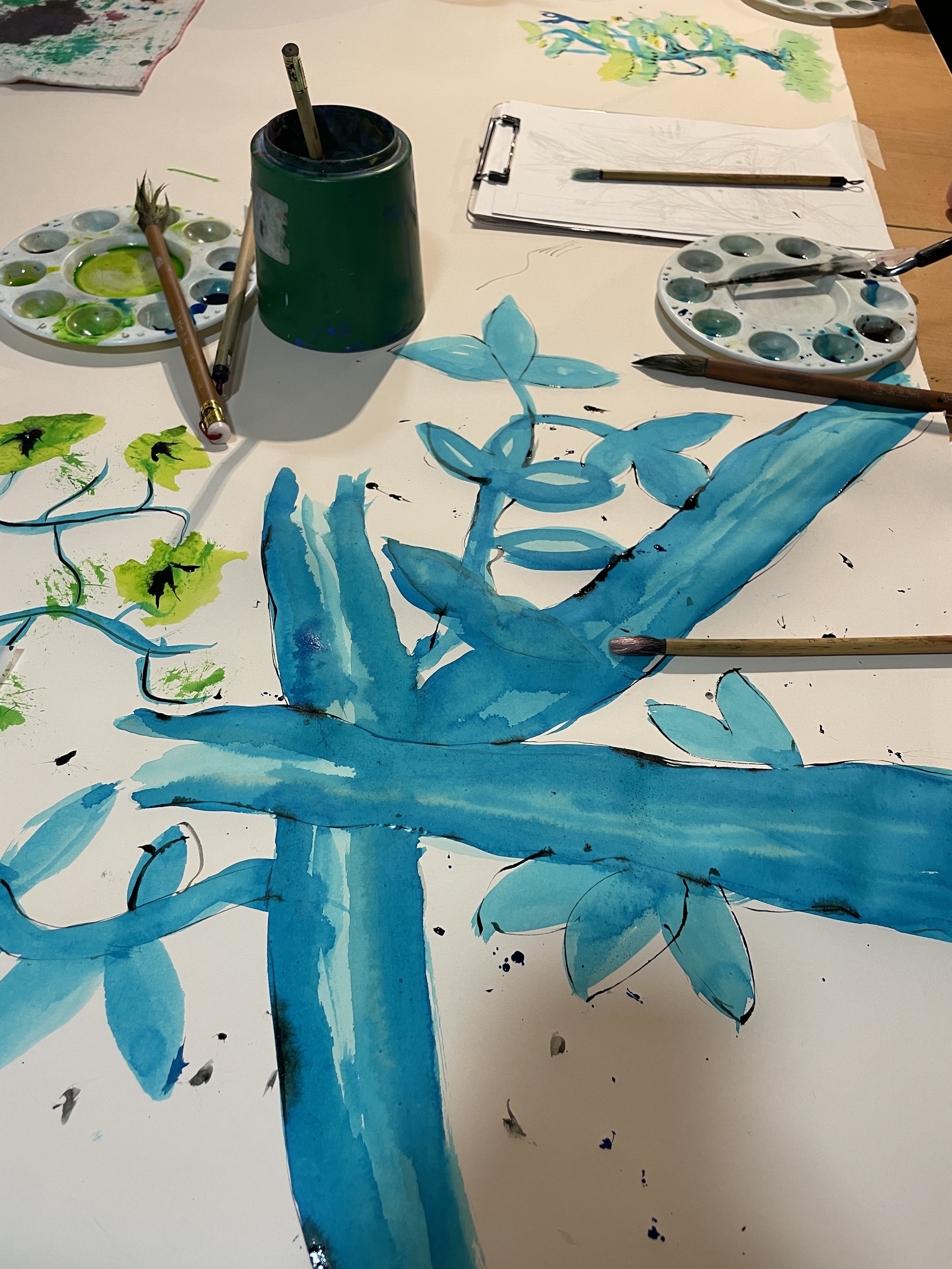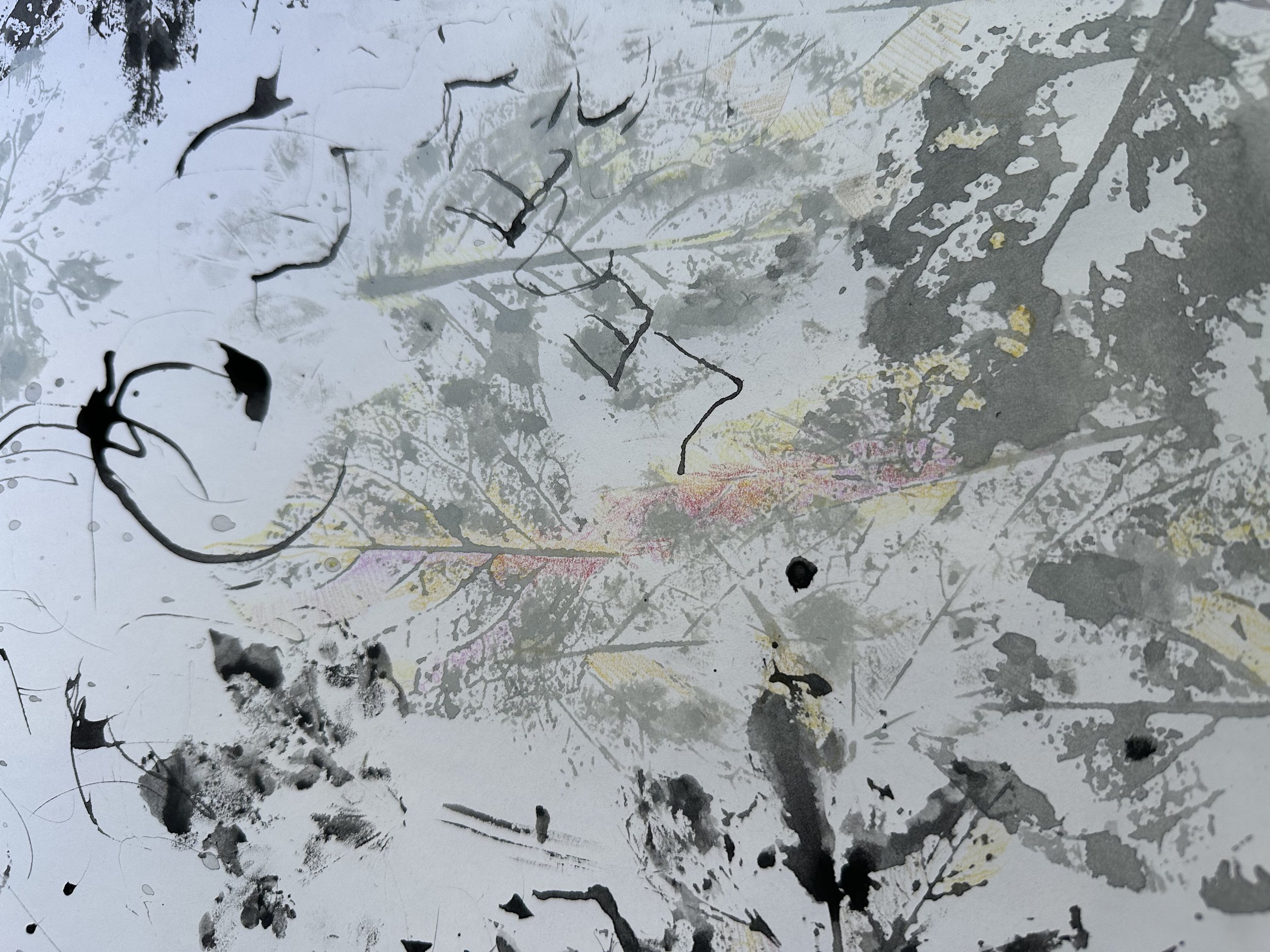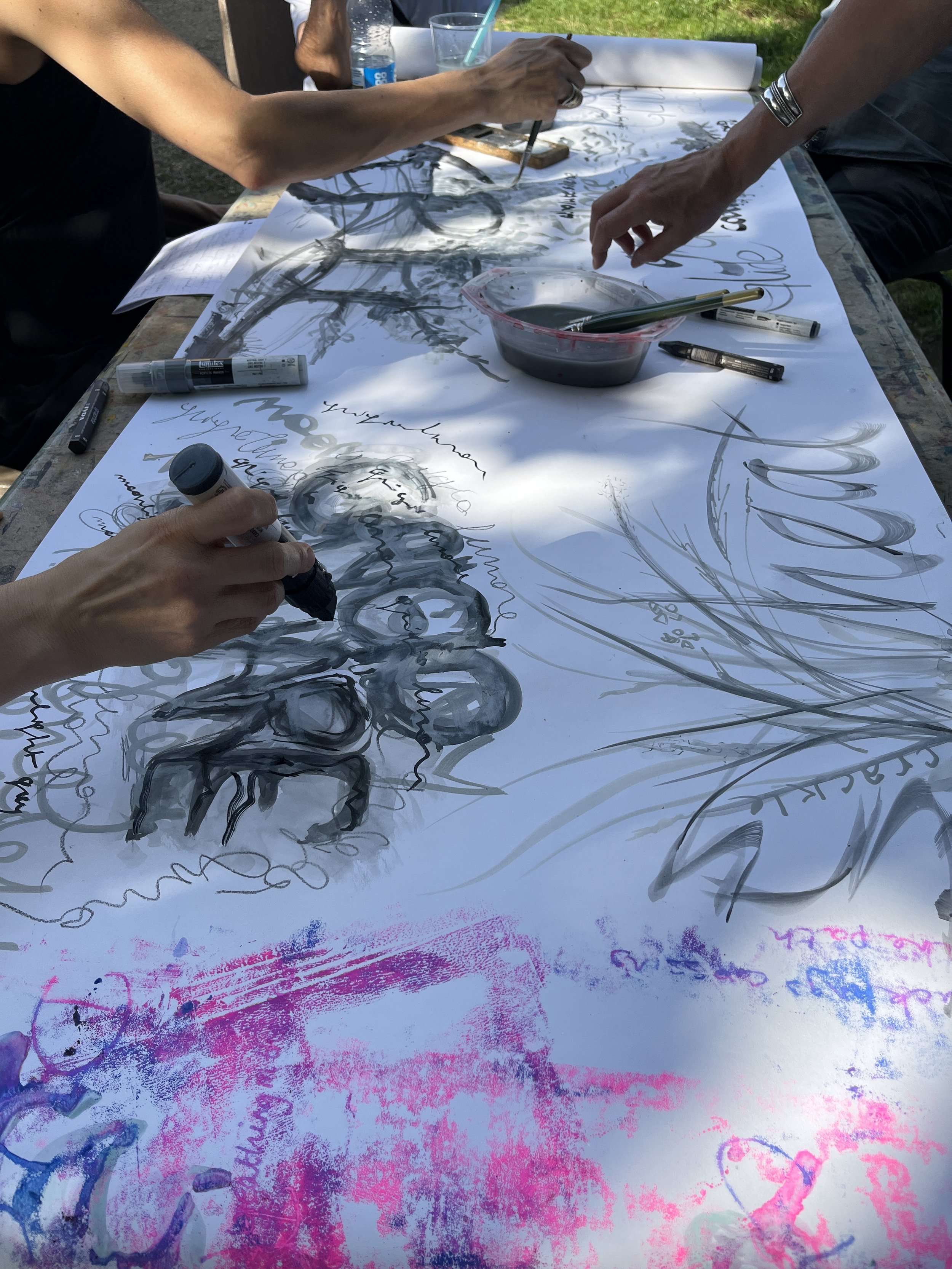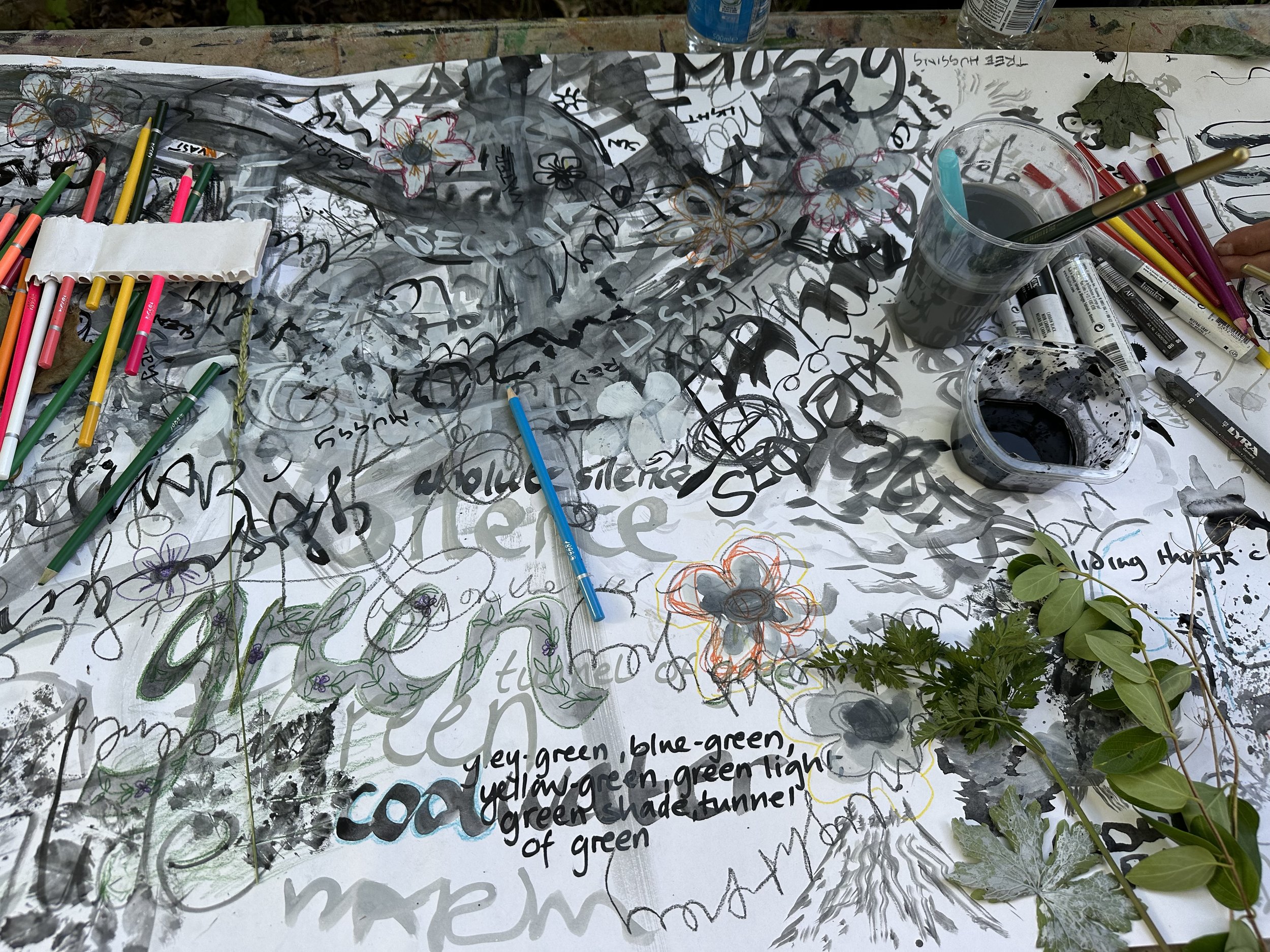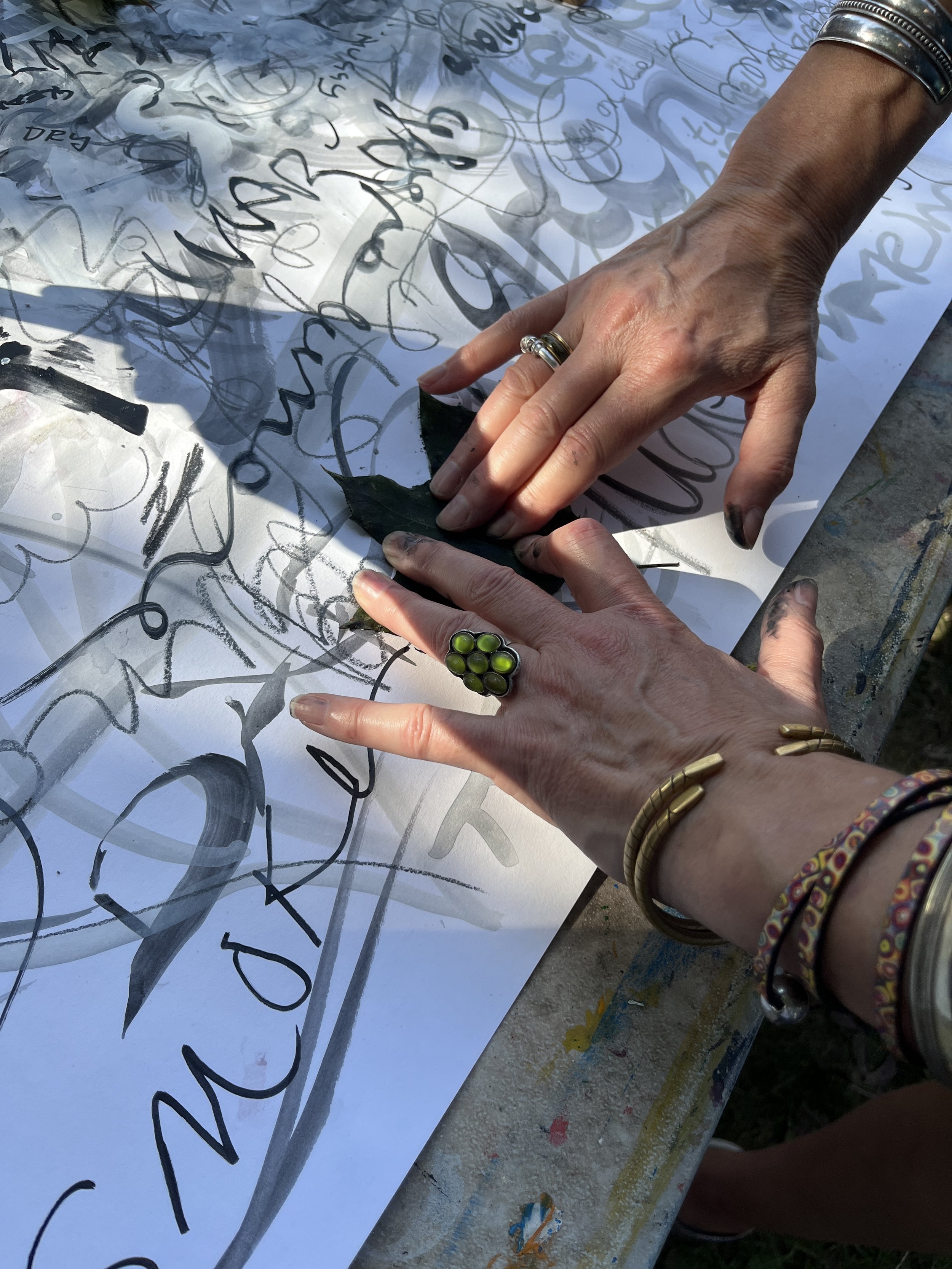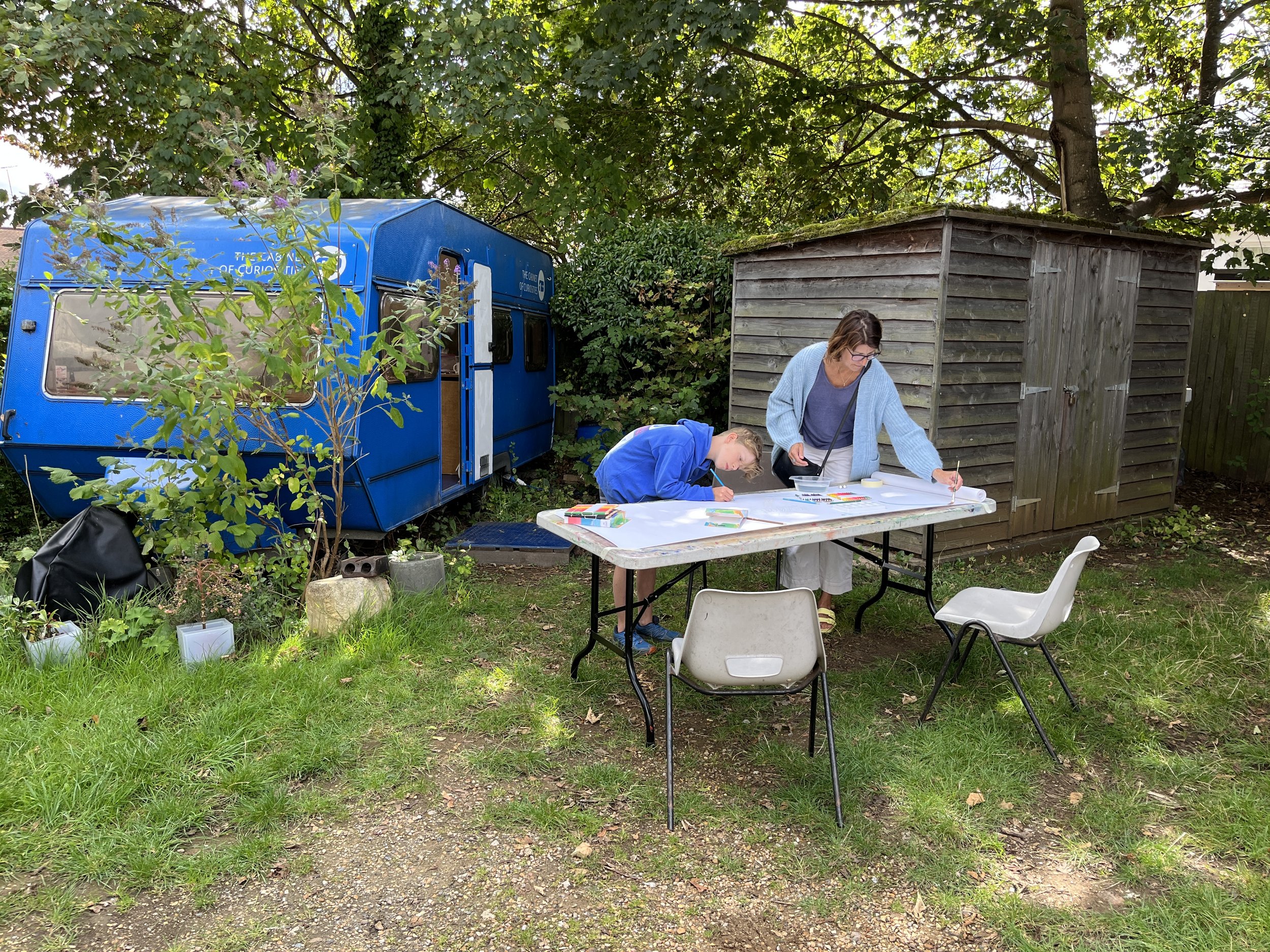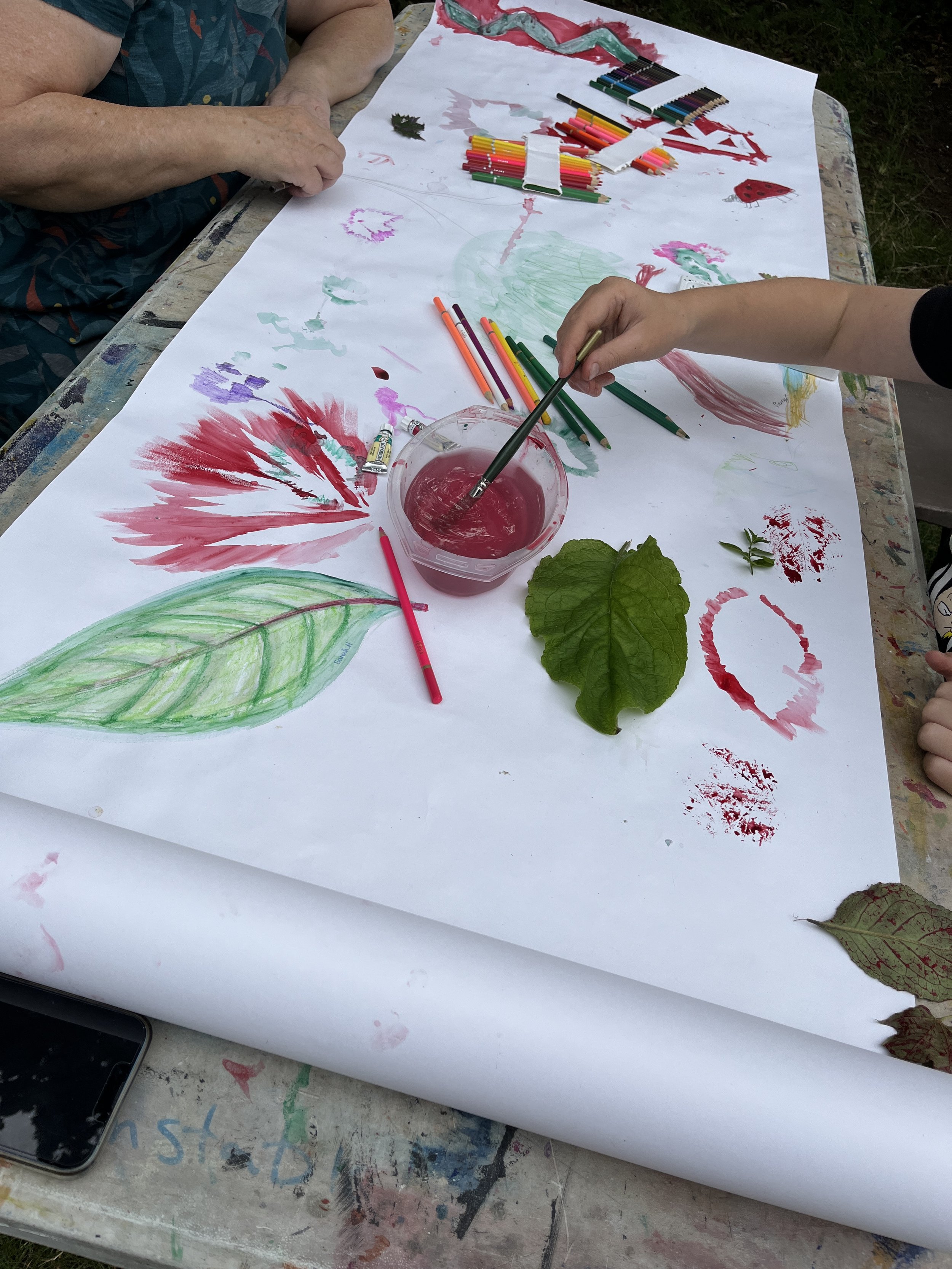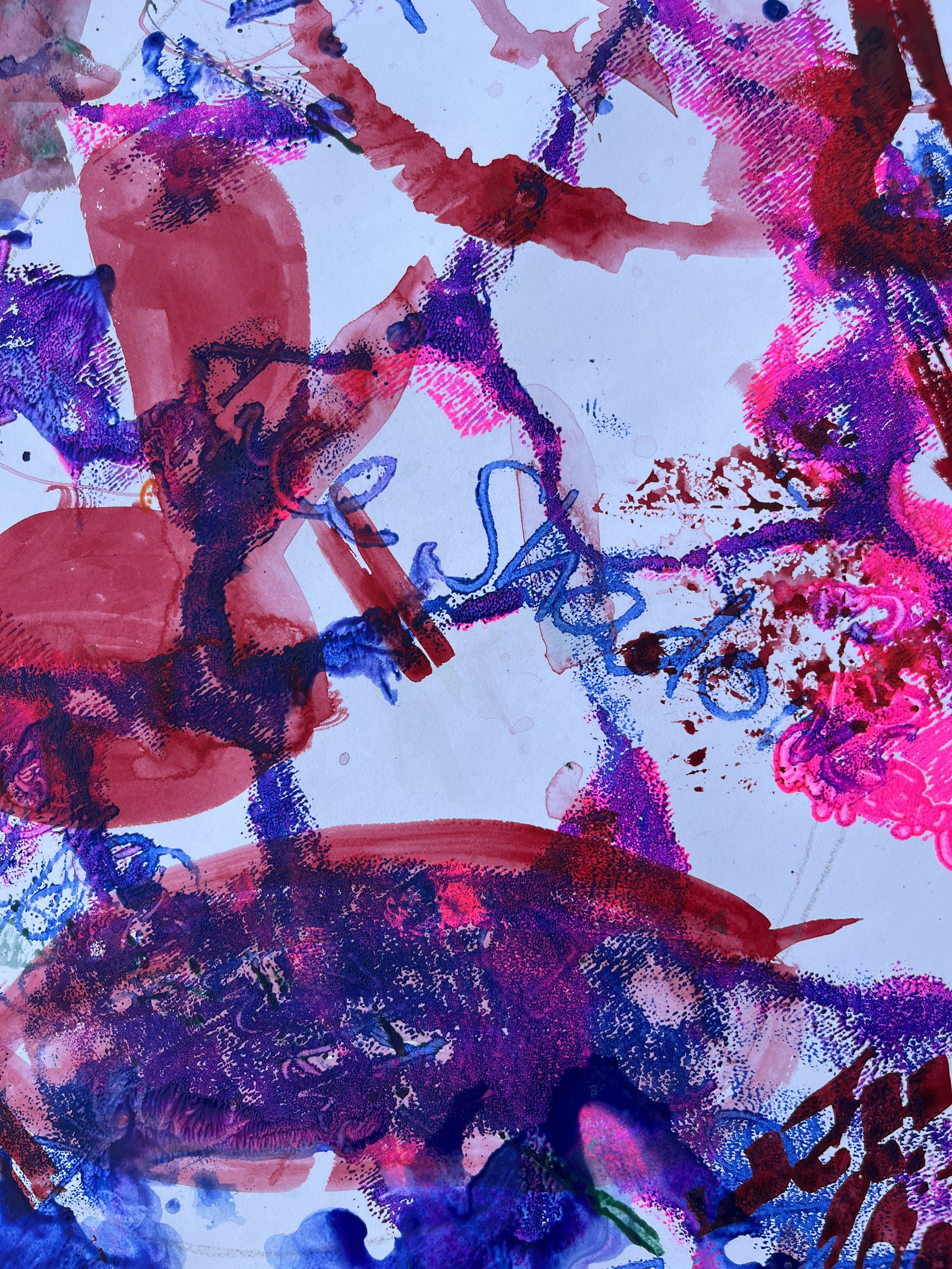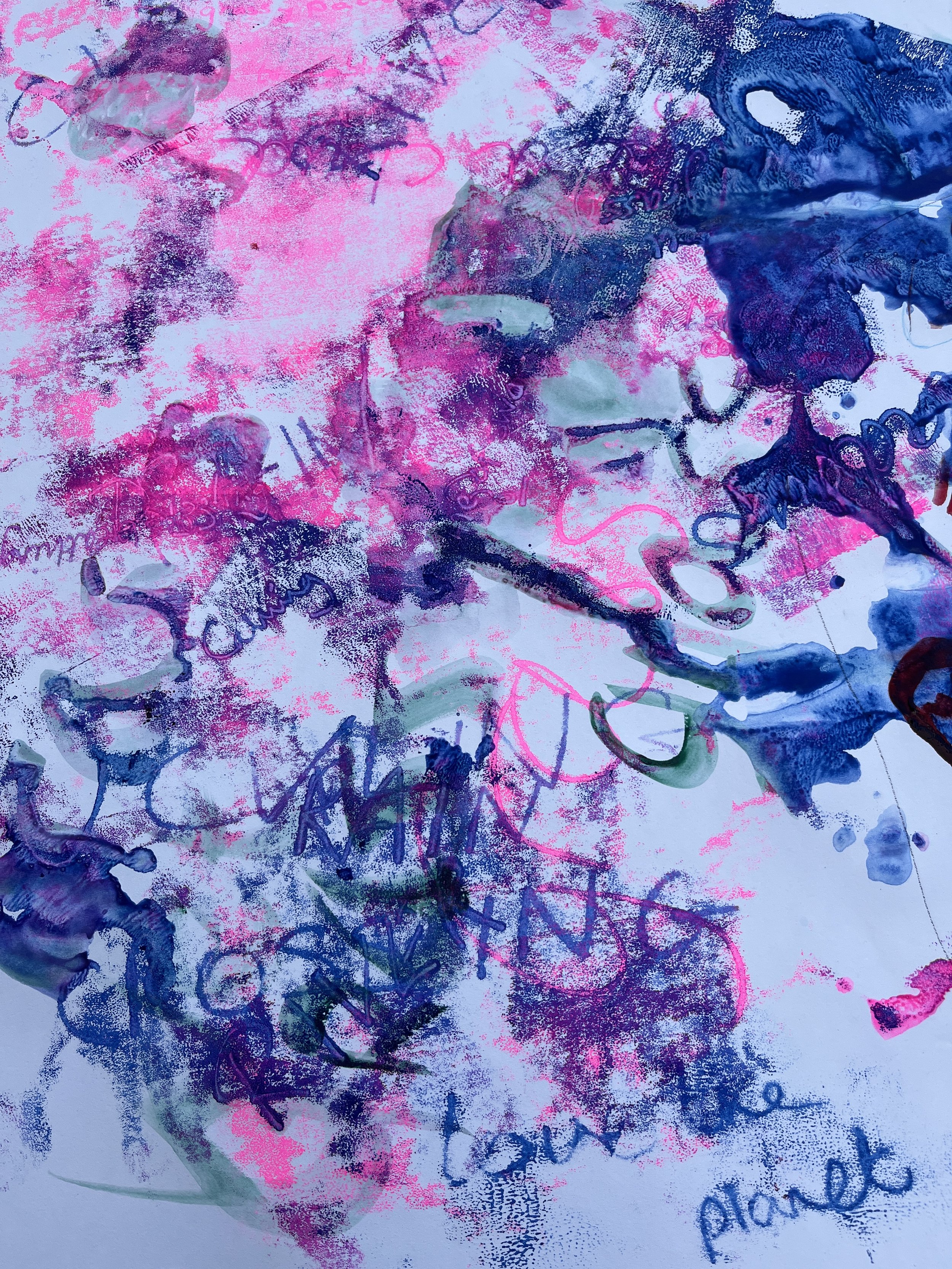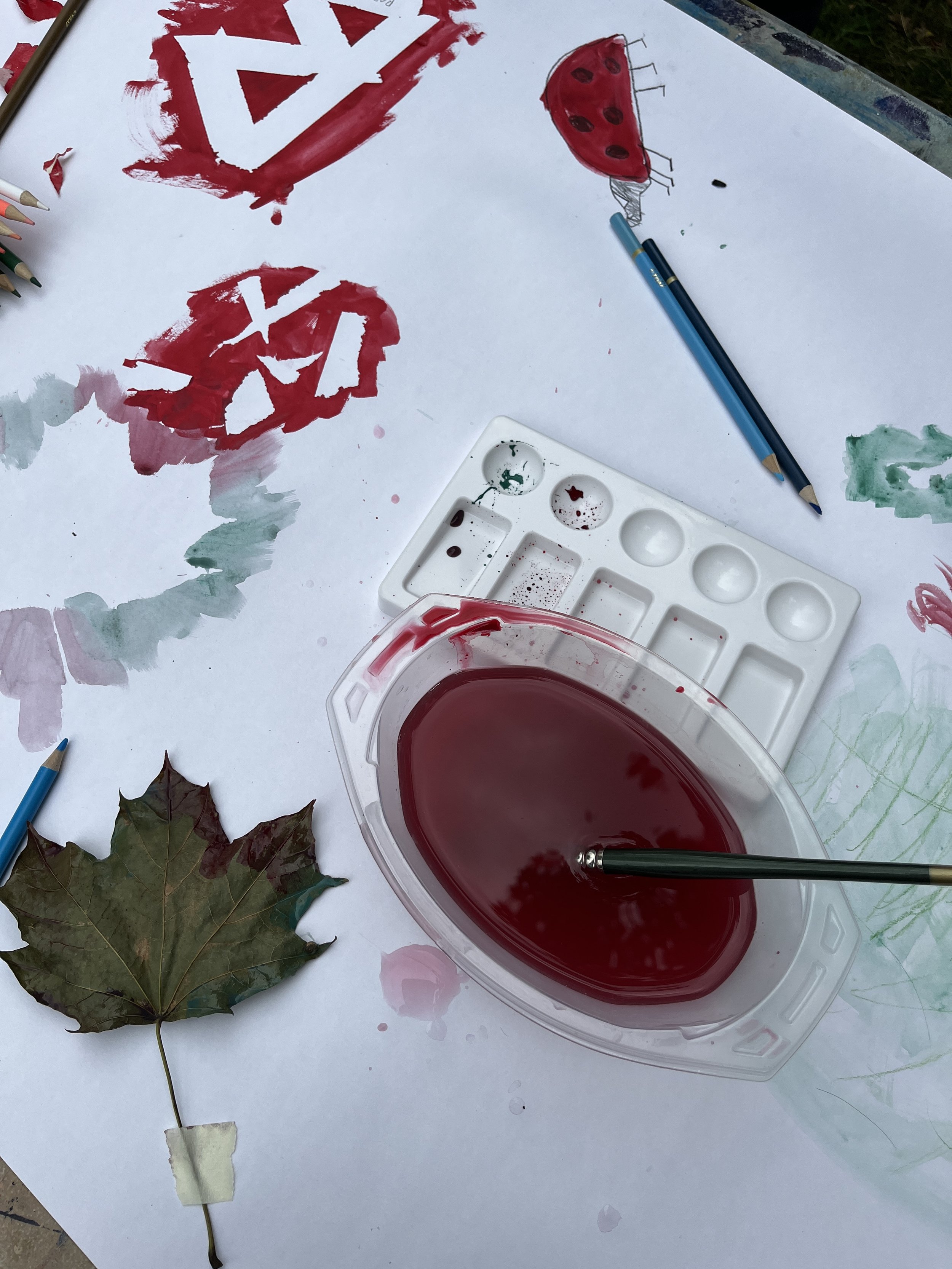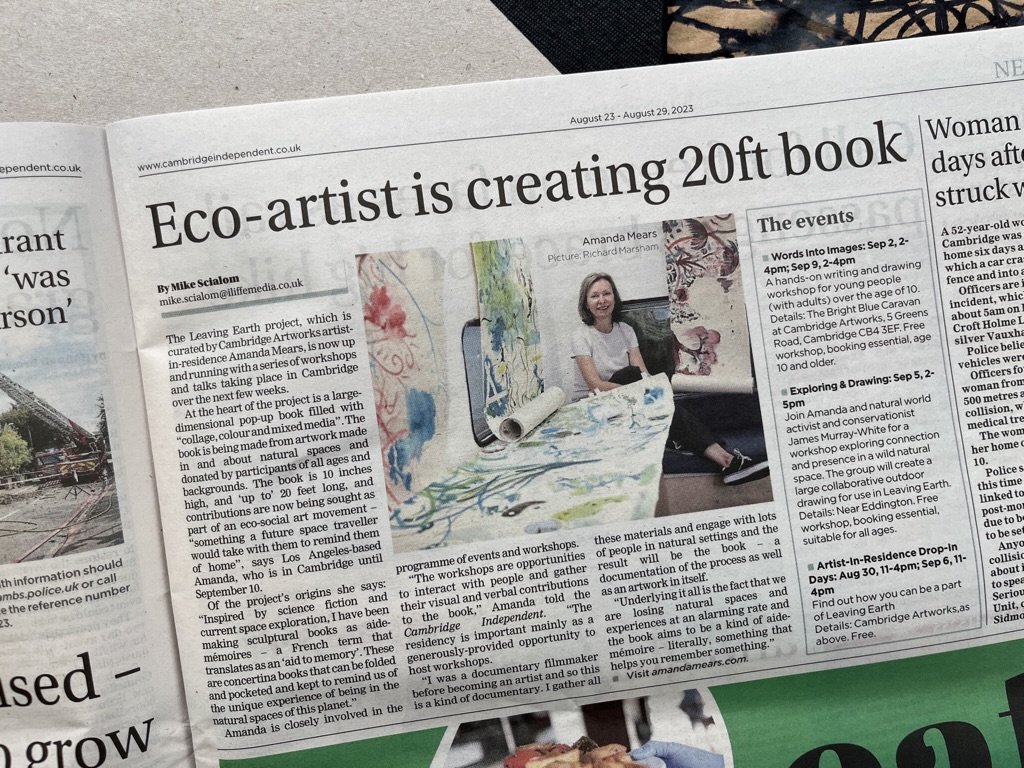The Leaving Earth Project
An international, eco-social, collaborative book-making project led by Amanda Mears.
If you found yourself leaving Earth on an interplanetary Ark, what would you take to remind you of the beautiful planet you are leaving behind? Perhaps a book that reminds you of all that you once had?
Welcome to the Leaving Earth Project
Leaving Earth is an artist book project created by painter and book artist Amanda Mears to foster engagement with nature through community workshops and collaborations all over the world. It is an extension of my painting practice in that it is about a deep engagement with the climate-crisis-challenged landscapes we inhabit.
“Amanda truly inspired me to appreciate the patterns of shadows of plants, trees, flowers and all of the structures around us. She introduced me to a world of art I didn’t know existed – that which is ethereal and mystical … shadows”
– Jay Renge, participant in Leaving Earth workshop at Torrance Art Museum
Leaving Earth workshops focus on observing and recording responses to nature visually or through writing. As an eco-social project, the goal is always to engage participants with our beautiful planet. All the artwork, written content, and the construction of the book itself are taking place in socially engaged events all over the world. Click here to meet the institutions and artists who are currently supporting and creating Leaving Earth.
My hope is that when Leaving Earth is finished it will travel widely and continue to inspire conversations about the environment and climate change. The title reflects contemporary dystopian imagery of humans being forced to leave Earth. What would you take with you from a burning planet? Perhaps a book that reminds you of all that you once had?
A 3-D Sculptural Book
When complete, Leaving Earth will be a 3D pop-up-style book that stretches almost twenty-one feet/ 6 meters in length. Seen as a whole, the book will be a gradient of color shifting from the cool tones of the morning to the golden hour and into the night. Seen up close it will be a series of hand-cut pop-up style dioramas evoking through color and texture the visual experience of being on earth.
Be a part of the conversation …
Are you in a drawing group? Or a plein air club, a writing group, a knitting or embroidery circle, a youth organisation? If you or your community would like to take part in this project, email me at leavingearthproject@gmail.com.
Click here to read more about my collaborators.
An International Collaboration
I am proud to have so many collaborators on my Leaving Earth Project.
Laura Fox - Maria Di Gaetano - Emanuela Cusin - Nicole Portieri - Cambridge Artworks - Lois Mears - Kelvin Duckett - Sarah Hill - Barney Hill - Torrance Art Museum - THANK YOU - Janet Morris - Dietra Charles - Veronique Chance - Sarah Cate Blake - The Fitzwilliam Museum - Arezoo Bharthania - THANK YOU - Eduardo Aispuro - Merdyce Maclaran - Dimitra Skandali - Marcus Masaki - Mark Kelly - Lisi Buongiorno - Emily Pallin - Christine Nakashima - THANK YOU -
〰️
Laura Fox - Maria Di Gaetano - Emanuela Cusin - Nicole Portieri - Cambridge Artworks - Lois Mears - Kelvin Duckett - Sarah Hill - Barney Hill - Torrance Art Museum - THANK YOU - Janet Morris - Dietra Charles - Veronique Chance - Sarah Cate Blake - The Fitzwilliam Museum - Arezoo Bharthania - THANK YOU - Eduardo Aispuro - Merdyce Maclaran - Dimitra Skandali - Marcus Masaki - Mark Kelly - Lisi Buongiorno - Emily Pallin - Christine Nakashima - THANK YOU - 〰️
Tap here to meet the institutions, individuals, and community groups that have supported Leaving Earth by providing material or financial support. Many artist collaborators are working independently with their own communities to create artwork for the book.
Please reach out to me via email if you are interested in becoming a collaborator.
Help me turn the map red …
Red marks places collaborators have come from so far, contact me to add your voice to the project.
More About Amanda Mears’ Leaving Earth Project
Inspired by science fiction and current space exploration, I have been making sculptural books as aide-mémoires - a French term that translates as an 'aid to memory'. These are concertina books that can be folded and pocketed and kept to remind us of the unique experience of being in the natural spaces of this planet. I imagine them as something a future space traveler would take with them to remind them of home.
A Book for The Museum of Art and History on Mars
Imagine that you are at the inaugural show at the Museum of Art and History on Mars. The centerpiece of this first show is surprisingly analog, something from the old planet with a rich art historical heritage: a handmade book. The book, titled “Leaving Earth” is a three-dimensional sculptural concertina that stretches almost twenty-one feet in length. Seen as a whole, the book is a gradient of color that shifts from the cool tones of morning to the golden hour and into night. Seen up close it is a series of hand-cut pop-up style dioramas evoking through color and texture the visual experience of being on earth.
Filled with collage, color, and mixed media, “Leaving Earth” has all the accessibility and wonder of a pop-up book. To museum-visiting Martians inhabiting a monochrome landscape, the book would be a glimpse into the unimaginable visual and tactile richness of a lost planet, while to today’s visiting earthlings it is a clarion call to conserve and value what we have.
Why is the Book Called Leaving Earth?
While this project is couched in science fiction, we actually do live in a time where climate change and habitat loss are very real concerns for life on Earth.
Habitat loss means fewer wild spaces for plants, animals, and humans. Access to natural spaces is also being impacted – this summer in LA the entire mountain areas north of the city were closed to public access due to increased fire risk. Campsites are now regularly closed for the same reason. North American National Parks are considering a lottery system for access and rising water levels threaten the coastal villages in Devon, England where I spent my childhood, as well as countless other coastal cities and island nations. Biodiversity has reduced enormously in living memory. My father remembers a very different climate in England when he was growing up: more birds and wild animals, a smaller less impactful population, and a more direct connection to the land and nature.
“Sometimes I picture a botany book in the future saying something like, “The lilac is now extinct. Its fragrance is thought to have been something similar to … and then what can they say?” – Andy Warhol, “A to B”
I believe Leaving Earth will be an innovative memory cache that speaks simultaneously to our most precious memories of this world, our interstellar future, and the sense of loss so many of us already feel in the present.
What Would You Miss Most About Life on Earth?
In Tarkovsky’s movie of Stanisław Lem’s novel “Solaris,” we find the astronaut Kris Kelvin walking through the countryside near his home before leaving for a mission. He looks at the mist, the tree shadows, and the weeds winding in the flow of the river. He caches these memories. He may never return to earth. He is experiencing the loss of these things before he loses them. This is what my sculptural books aim to do. They are ways of recording, evoking, storing, and preserving what is soon to be lost, what is being lost. In the current climate situation, where natural spaces are under threat and many no longer have the privilege of access to nature, we are all like Kris Kelvin because we too may only be left with memories.
“What did that word mean to me? Earth?” ― Stanisław Lem, Solaris
What effects of the light, what views and experiences would you most miss from our home planet? If you found yourself about to board an interplanetary Ark, what would you want to take with you to remind you of what you are leaving behind? Perhaps a book that reminds you of all that you once had?
Astronaut Kris Kelvin says goodbye to Earth in Tarkovsky’s film Solaris.
How is the Leaving Earth Book Being Made?
Leaving Earth will be in concertina format like my other books but considerably bigger at 10 inches/ 25 cm high and up to 20 feet / 6 meters long. All the materials for the book are currently being gathered through free public workshops and community outreach. Presence in nature is the central theme of Leaving Earth so workshops focus on observing and recording responses to the natural environment visually or through writing.
Workshops for Leaving Earth have been supported by institutions including The University of Cambridge’s Fitzwilliam Museum (UK) and The Torrance Art Museum (Los Angeles). Artist collaborators from around the world are also bringing their communities’ unique voices and techniques to the project.
The final phase of Leaving Earth will be a collaborative assembly of the gathered materials led by artist collaborators. In this phase, all the different ways participants have recorded details from nature will come together to create a layered, three-dimensional book. The colors, shapes, words, and imagery might evoke a childhood memory of a stream, the pleasure of wild swimming, a picnic under dappled tree shadows, or remembered meadows, mountains, and wetlands.
How Will People Experience the Leaving Earth Book?
Handmade books are traditionally an elitist medium unaffordable except to wealthy collectors. Leaving Earth aims to reach an audience beyond a private collection or art museum. Because Leaving Earth folds up, it is easily transported. My hope is that Leaving Earth will travel widely to libraries and schools, government buildings, and other community spaces as well as traditional art venues.
Portable and accessible, reminiscent of a pop-up book, it should be full of wonder and open to engagement with diverse audiences. Leaving Earth is not dystopian or didactic, it is an aide-mémoire of a beautiful, diverse planet. It is both a celebration and a warning. I hope that Leaving Earth will continue its life as an ongoing conversation about climate change and global equity.
“We really had it all didn’t we.” - Leonardo DiCaprio – “Don’t Look Up”, 2021
Press for The Leaving Earth Project
Cambridge Independent interviewed Amanda Mears about the Leaving Earth Project
Tap here to read the online version of the Cambridge Independent article.





